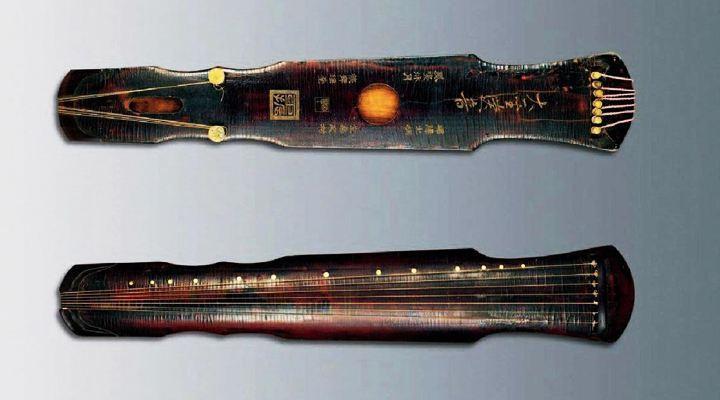The Origin and Historical Development of Guqin
Ancient books record that the creation of the qin was related to the emperors at the beginning of Chinese civilization. It is a traditional Chinese musical instrument with a history of at least 3,500 years.
The earliest written records about the qin can be found in the "Book of Songs" and other classics. During the Zhou Dynasty, the guqin was not only used in suburban temple sacrifices, court meetings, ceremonies and other elegant music, but also flourished in the folk. The Zhou Dynasty was a musical instrument that was very common among the people and was very popular among the ancients. In ancient times, people's recognition was quite extensive.
According to "Historical Records", the qin appeared no later than the period of Yao and Shun. The earliest guqin discovered by archaeology is a qin from the early Spring and Autumn Period of the Zeng Kingdom of the Zhou Dynasty unearthed in Guojiamiao, Zaoyang, Hubei in 2016. It is about 2700 years ago, and the history of the qin in my country with physical evidence is about 300 years ahead.

Pre-Qin
Zhong Yi in the Western Zhou Dynasty was the earliest professional qin player in existing records. There are also a lot of records about the qin in the "Book of Songs" and other literary works. During the Warring States Period, with the development of music, qin music has also been greatly developed and popularized, and a large number of qin players have emerged, such as Boya and Zhong Ziqi. The classic chanting of high mountains and flowing water meeting bosom friend through the ages.
Confucius, the founder of Confucianism, highly respected the qin. He could play the qin and sing 300 Books of Poems. In later generations, there are two qin pieces, "Confucius Reading Yi" and "Weeping Yan Hui".
The Han Dynasty
The type of the qin was determined in the late Eastern Han Dynasty. The early Han lyre unearthed from Mawangdui Han Tomb No. 3 has a simple structure, small speakers, and low resonance. The tail is made of solid wood, and the panel has no emblem. From the Eastern Han Dynasty to the Wei and Jin Dynasties, the qin was very popular among scholars.
Wei and Jin
During the period of war and strife, a large number of literati qin players appeared in the gentry class, such as "Jian'an Seven Sons" and "Bamboo Forest Seven Sages". Ji Kang's "Changqing", "Short Qing", "Long Side" and "Short Side" 4 pieces, collectively known as "Ji's Four Lanes". There are "Qin Fu", "Sound without sorrow and music theory" and so on. Ruan Yu, Ji Kang, Ruan Ji, Ruan Xian and Ruan Zhan were among the famous qin players during this period.
Southern and Northern Dynasties
During the Northern and Southern Dynasties, the monarchs and scholars were fond of music and literature, and the literati loved the qin to decipher the sound, which was very popular. Due to the restrictions on the literati by the gentry system, many literati were cynical and entertained themselves with qin books.
Sui and Tang Dynasties
During the Sui and Tang Dynasties, Yan music and dance were popular, but the style of the piano fell slightly. Dong Tinglan is good at playing "Hu Jia" and other songs, and the spread works include "Yi Zhen", and the qin was also spread to Korea and Japan in the early Tang Dynasty.
Song and Yuan Dynasties
Since the Song Dynasty exercised the policy of suppressing martial arts and promoting literature, since Emperor Taizong of the Song Dynasty, from the emperor to the court and the public, everyone was very fond of the qin, and they all took pride in being able to play the qin, reaching the peak of good qin in all dynasties. During the Song and Yuan Dynasties, the qin began to have a clear style inheritance.
Ming and Qing Dynasties
During the Ming and Qing Dynasties, there were many genres, and a large number of piano scores were published. In the late Qing Dynasty, the art of qin declined relatively.
Modern times
During the Republic of China, the qin spread to Southeast Asia, Europe, America and Australia along with the literati. Especially after the reform and opening up, a large number of Chinese were overseas. So far, it has been used in Malaysia, Singapore, the United States, Canada, Germany, the United Kingdom, the Netherlands and Sweden. There are violinists and violin clubs.
Modern
Due to the decline of the guqin and the cultural ideas it symbolizes, on November 7, 2003, the art of guqin was included in the second batch of representative works of human intangible cultural heritage in the world by UNESCO. On May 20, 2006, the State Council of the People's Republic of China listed the guqin in the first batch of national intangible cultural heritage list, classified in the category of "folk music", number II-34.
 渝公网安备 50010702504639号
渝公网安备 50010702504639号